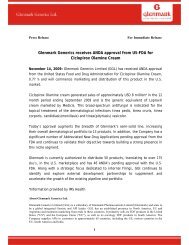Download - Glenmark
Download - Glenmark
Download - Glenmark
Create successful ePaper yourself
Turn your PDF publications into a flip-book with our unique Google optimized e-Paper software.
money and the risks specific to the asset. For the purpose of impairment testing, assets are grouped together<br />
into the smallest group of assets that generates cash inflows from continuing use that are largely independent<br />
of the cash inflows of other assets or groups of assets (the “cash-generating unit”). The goodwill acquired in<br />
a business combination is, for the purpose of impairment testing, allocated to cash-generating units that are<br />
expected to benefit from the synergies of the combination.<br />
An impairment loss is recognised if the carrying amount of an asset or its cash-generating unit exceeds its<br />
estimated recoverable amount. Impairment losses are recognised in income statement. Impairment losses<br />
recognised in respect of cash-generating units are allocated first to reduce the carrying amount of any goodwill<br />
allocated to the units and then to reduce the carrying amount of the other assets in the unit on a pro-rata basis.<br />
An impairment loss in respect of goodwill is not reversed. In respect of other assets, impairment losses<br />
recognised in prior periods are assessed at each reporting date for any indications that the loss has decreased<br />
or no longer exists. An impairment loss is reversed if there has been a change in the estimates used to determine<br />
the recoverable amount. An impairment loss is reversed only to the extent that the asset’s carrying amount does<br />
not exceed the carrying amount that would have been determined, net of depreciation or amortisation, if no<br />
impairment loss had been recognised.<br />
3.11 FINANCIAL INSTRUMENTS<br />
Financial assets and financial liabilities are recognised when the Group becomes a party to the contractual<br />
provisions of the financial instrument.<br />
Financial assets are derecognised when the contractual rights to the cash flows from the financial asset expire,<br />
or when the financial asset and all substantial risks and rewards are transferred.<br />
A financial liability is derecognised when it is extinguished, discharged, cancelled or expires.<br />
Financial assets and financial liabilities are measured initially at fair value plus transaction costs, except for<br />
financial assets and financial liabilities carried at fair value through income statement, which are measured<br />
initially at fair value. Financial assets and financial liabilities are measured subsequently as described below.<br />
3.12 FINANCIAL ASSETS<br />
Non-derivative financial instruments consists of investments in equity and debt securities, trade receivables,<br />
certain other assets, cash and cash equivalents, loans and borrowings, trade payables and certain other<br />
liabilities.<br />
Non-derivative financial instruments are recognised initially at fair value plus, for instruments not at fair value<br />
through profit or loss, any directly attributable transaction costs. Subsequent to initial recognition, non-derivative<br />
financial instruments are measured as described below.<br />
Cash and cash equivalents<br />
Cash and cash equivalents consist of current cash balances and time deposits with banks. Bank overdrafts<br />
that are repayable on demand and form an integral part of the Group’s cash management are included as a<br />
component of cash and cash equivalents for the purpose of the statement of cash flows.<br />
Held-to-maturity investments<br />
If the Group has the positive intent and ability to hold debt securities to maturity, then they are classified as<br />
held-to-maturity. Held-to-maturity investments are measured at amortised cost using the effective interest rate<br />
method, less any impairment losses.<br />
Available-for-sale financial assets<br />
The Group’s investments in equity securities and certain debt securities are classified as available-for-sale<br />
financial assets. Subsequent to initial recognition, they are measured at fair value and changes therein, other<br />
than impairment losses, are recognised in Other Comprehensive Income. When an investment is derecognised,<br />
the cumulative gain or loss in Other Comprehensive Income is transferred to income statement.<br />
Others<br />
Other non-derivative financial instruments are measured at amortised cost using the effective interest rate<br />
method, less any impairment losses.<br />
The Group holds derivative financial instruments to hedge its foreign currency exposure. Derivatives are<br />
recognised initially at fair value; transaction costs are recognised in income statement when incurred. Subsequent<br />
to initial recognition, derivatives are measured at fair value, and changes therein are recognised in income<br />
statement.<br />
3.13 FINANCIAL LIABILITIES<br />
The Group’s financial liabilities include trade and other payables, borrowings and derivative financial instruments.<br />
Payable and borrowings are initially measured at fair value and subsequently measured at amortised cost using<br />
effective interest rate method. They are included in statement of financial position line items ‘long-term liabilities’<br />
and ‘trade and other payables’.<br />
Derivative financial instruments that are not designated and effective as hedging instruments are accounted for<br />
at fair value through profit or loss.<br />
88<br />
GLENMARK PHARMACEUTICALS LIMITED



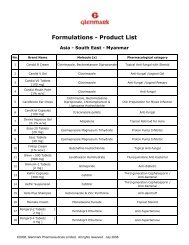


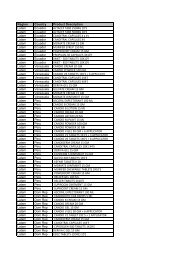
![Formulations [India] â Product List - Glenmark](https://img.yumpu.com/46601329/1/190x245/formulations-india-a-product-list-glenmark.jpg?quality=85)
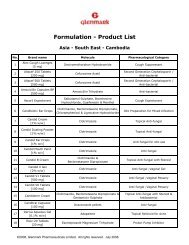
![Formulation [India] â Product List - Glenmark](https://img.yumpu.com/44013338/1/190x245/formulation-india-a-product-list-glenmark.jpg?quality=85)


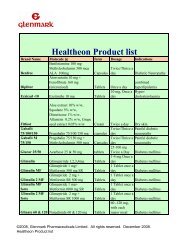
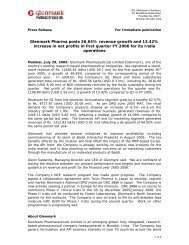
![Formulations [India] â Product List - Glenmark](https://img.yumpu.com/35994839/1/190x245/formulations-india-a-product-list-glenmark.jpg?quality=85)
